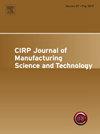Selection of a suitable wear-resistant metal matrix composite for remanufacturing continuous miner cutter (CMC) sleeves via a two-step laser-based technique
IF 5.4
2区 工程技术
Q2 ENGINEERING, MANUFACTURING
CIRP Journal of Manufacturing Science and Technology
Pub Date : 2025-05-08
DOI:10.1016/j.cirpj.2025.04.014
引用次数: 0
Abstract
The premature failure of continuous miner cutter (CMC) sleeves in underground coal mining necessitates remanufacturing to enable a closed-loop system and enhanced sustainable mining operations. However, a techno-economic analysis conducted revealed that exclusively using laser cladding (LC) to remanufacture failed sleeves is not economically viable. Thus, this research aims to explore a two-step laser-based remanufacturing technique that incorporates gas metal arc welding (GMAW) and LC, as well as identify suitable wear-resistant metal matrix composites (MMCs) for restoring damaged sleeves. Consequently, an LC process was used to deposit three MMC materials onto optimised GMAW overlays. A comparative analysis of the manufactured MMC coatings revealed that WC/TiC/AISI4340 coating exhibited a well-consolidated, crack- and pore-free microstructure and a superior microhardness of 931 HV0.5 compared to WC- and TiC-reinforced composites, which had average hardness values of 670 HV0.5 and 744 HV0.5, respectively. Additionally, the WC/TiC/AISI4340 coating demonstrated an excellent low wear rate (0.0007 g/s) comparable to TiC-reinforced coating, and a propensity to extend the sleeve’s lifespan by a factor of four. These enhancements are attributed to the formation of an umbrella-like network of TiC, predominantly distributed in the coating top region and solid solution strengthening [(Ti, W)C] caused by the partial dissolution of WC/TiC carbides and their precipitation into the eutectic carbide network within the interdendritic grain regions. Hence, combining GMAW and LC processes with WC/TiC/AISI4340 presents a promising remanufacturing strategy for restoring mining equipment, offering improved performance, longer lifespan, and economically viable and sustainable mining operations.
选择合适的耐磨金属基复合材料,通过两步激光技术再制造连续矿刀(CMC)套筒
煤矿井下连续采煤刀(CMC)套筒过早失效,需要对其进行再制造,以实现闭环系统,增强可持续开采作业。然而,一项技术经济分析表明,仅使用激光熔覆(LC)来再制造失效的套管在经济上是不可接受的。因此,本研究旨在探索一种两步激光再制造技术,该技术结合了气体金属弧焊(GMAW)和LC,并确定合适的耐磨金属基复合材料(mmc)来修复受损的滑套。因此,采用LC工艺将三种MMC材料沉积到优化的GMAW覆盖层上。对比分析表明,WC/TiC/AISI4340涂层具有固结良好、无裂纹、无孔隙的显微组织,显微硬度为931 HV0.5,高于WC和TiC增强复合材料(平均硬度分别为670 HV0.5和744 HV0.5)。此外,WC/TiC/AISI4340涂层具有优异的低磨损率(0.0007 g/s),可与TiC增强涂层相媲美,并可将套管的使用寿命延长4倍。这些增强的原因是主要分布在涂层顶部的TiC伞状网络的形成,以及WC/TiC碳化物的部分溶解和在枝晶间区域内析出的共晶碳化物网络引起的固溶体强化[(Ti, W)C]。因此,将GMAW和LC工艺与WC/TiC/AISI4340相结合,为恢复采矿设备提供了一种有前途的再制造策略,提供了更好的性能,更长的使用寿命,以及经济上可行和可持续的采矿作业。
本文章由计算机程序翻译,如有差异,请以英文原文为准。
求助全文
约1分钟内获得全文
求助全文
来源期刊

CIRP Journal of Manufacturing Science and Technology
Engineering-Industrial and Manufacturing Engineering
CiteScore
9.10
自引率
6.20%
发文量
166
审稿时长
63 days
期刊介绍:
The CIRP Journal of Manufacturing Science and Technology (CIRP-JMST) publishes fundamental papers on manufacturing processes, production equipment and automation, product design, manufacturing systems and production organisations up to the level of the production networks, including all the related technical, human and economic factors. Preference is given to contributions describing research results whose feasibility has been demonstrated either in a laboratory or in the industrial praxis. Case studies and review papers on specific issues in manufacturing science and technology are equally encouraged.
 求助内容:
求助内容: 应助结果提醒方式:
应助结果提醒方式:


